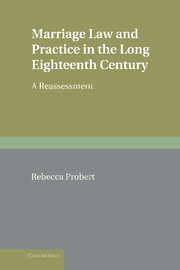Book contents
- Frontmatter
- Contents
- Preface
- 1 Introduction
- 2 The misunderstood contract per verba de praesenti
- 3 The myths of ‘informal’ and ‘common-law’ marriage
- 4 The little-considered marriage practices of non-Anglicans
- 5 The unacknowledged regularity of clandestine marriages
- 6 The eventual passage and actual terms of the 1753 Act
- 7 The unappreciated success of the 1753 Act
- 8 The unexplored judicial interpretation of the 1753 Act
- 9 The overlooked response of non-Anglicans
- 10 Conclusion
- Index
- References
4 - The little-considered marriage practices of non-Anglicans
Published online by Cambridge University Press: 10 February 2010
- Frontmatter
- Contents
- Preface
- 1 Introduction
- 2 The misunderstood contract per verba de praesenti
- 3 The myths of ‘informal’ and ‘common-law’ marriage
- 4 The little-considered marriage practices of non-Anglicans
- 5 The unacknowledged regularity of clandestine marriages
- 6 The eventual passage and actual terms of the 1753 Act
- 7 The unappreciated success of the 1753 Act
- 8 The unexplored judicial interpretation of the 1753 Act
- 9 The overlooked response of non-Anglicans
- 10 Conclusion
- Index
- References
Summary
Since, as discussed in earlier chapters, it has been widely supposed among commentators that the mere exchange of consent constituted a valid marriage before March 1754, little attention has been paid to the status of marriages that were celebrated according to religious rites other than those of the Church of England. It has simply been assumed that dissenters did marry according to their own rites and that such ceremonies were valid, if perhaps clandestine in the eyes of the law, since they would have the same status as a contract per verba de praesenti. Yet once it has been established that such a contract was not regarded as a marriage, questions about the status of such ceremonies inevitably arise. Were the marriages of Protestant dissenters treated as no more than contracts, or did the fact that the marriage was celebrated by a minister, albeit a dissenting one, make any difference to the status of such ceremonies? And what about Quaker marriages, which involved no minister, or those of Catholics, who were prevented from practising their faith freely, or those of non-Christians?
- Type
- Chapter
- Information
- Marriage Law and Practice in the Long Eighteenth CenturyA Reassessment, pp. 131 - 165Publisher: Cambridge University PressPrint publication year: 2009



